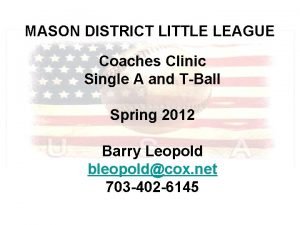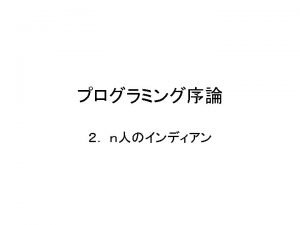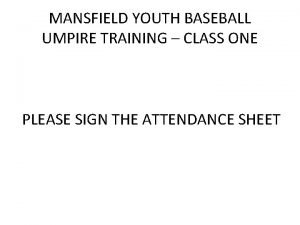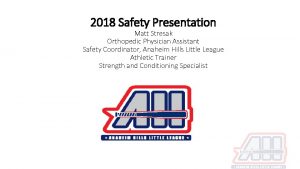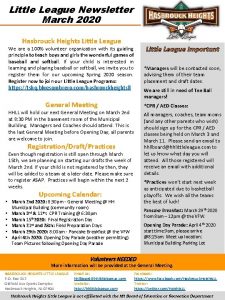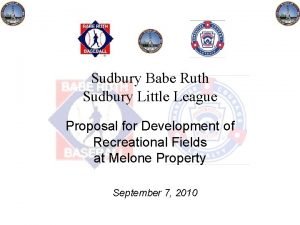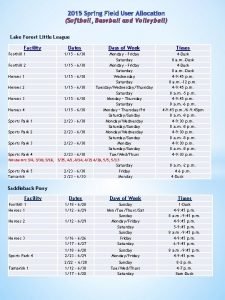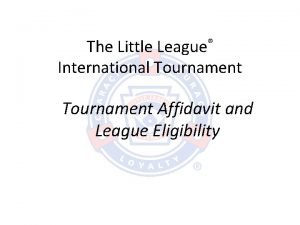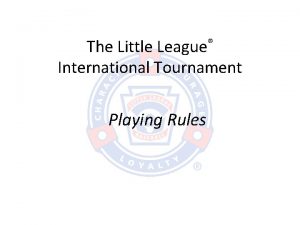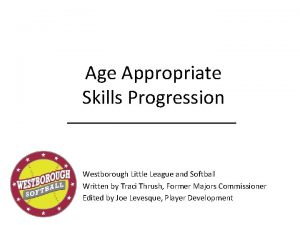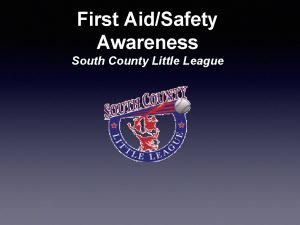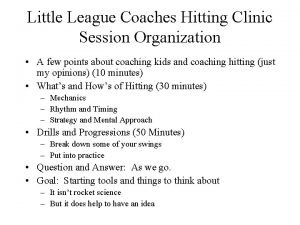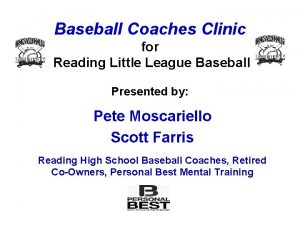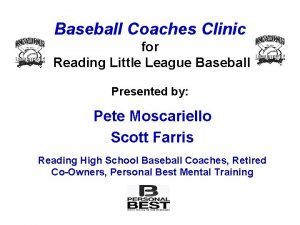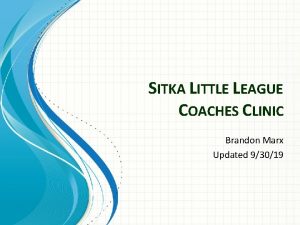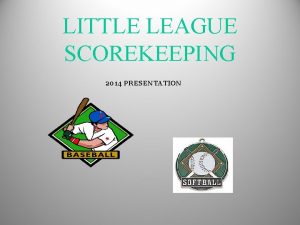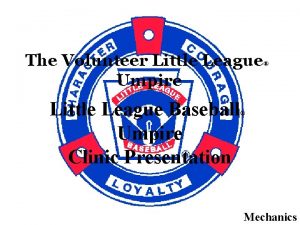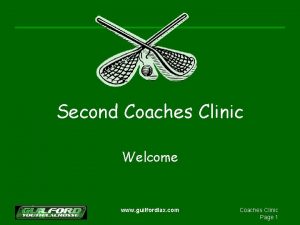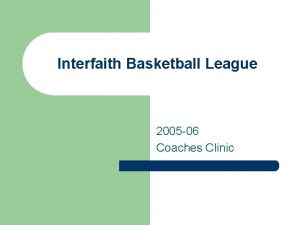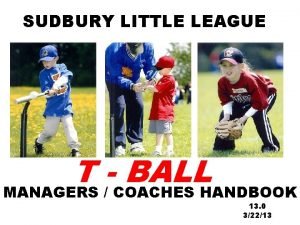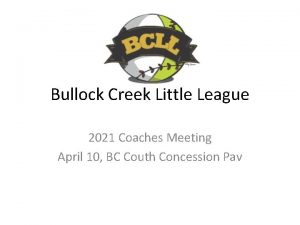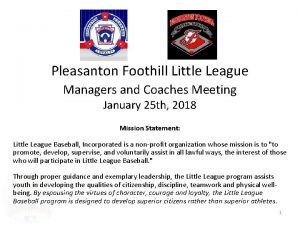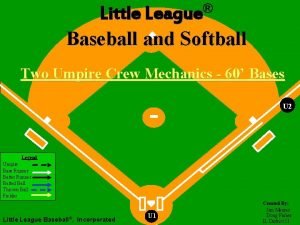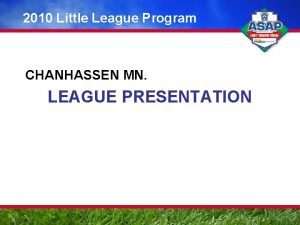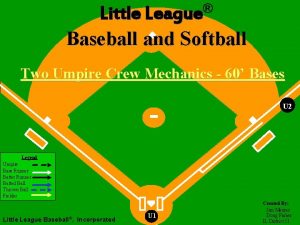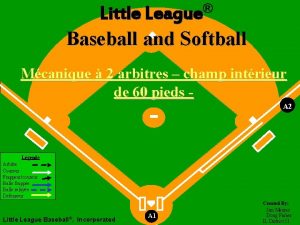MASON DISTRICT LITTLE LEAGUE Coaches Clinic A AA
























- Slides: 24

MASON DISTRICT LITTLE LEAGUE Coaches Clinic A, AA and T-Ball Divisions Spring 2014 Barry Leopold MDLL Coaching Coordinator bleopold@cox. net 703 -402 -6145

Agenda n Intro Remarks n Team Organization n Practice Organization n Skill Training n Game Organization and Strategy n Strategies/Tips/Resources n (What Else Should We Cover? )

First of All… n n Thank you for coming and for agreeing to help run a team Coaching can be a ton of fun, providing you feel prepared and get the support you need Your Success will be measured by how may of your kids come back next season Please look at this as a teaching gig

Intro (continued) Goals for this Session n Make you feel more prepared and comfortable coaching at this level n Give you tips, strategies and drills you can use n Standardize the way we teach baseball skills throughout MDLL Divisions

Team Organization n It all starts with the Parent Meeting ¨ Set expectations n Get volunteers !!! This is not a solo effort! ¨ ¨ ¨ n n n Assistant Coaches Parent Helpers Team Parents Contact you if parent helpers or their kid(s) cannot make a practice or game Steal from existing written expectations or make your own set Get contact info for all families Get team parent to make snack schedule Don’t drop your kid off without seeing if a coach is there

Practice Organization n Have a plan for every practice ¨ ¨ n Know how many parents/helpers you can expect Use the Standards of Achievement if you get stuck Stations - keep them moving ¨ # of parents = # of stations n Don’t make them look into the sun n Different learning styles – visual, auditory, kinesthetic ¨ Explain (quickly!), demonstrate, then have them perform each school you teach

Practice Organization (cont) n Use the power of competition (group and individual competition) n Stress Safety at All Times !!! n Don’t be a screamer! ¨ Use timeouts when needed ¨ Have activities you can pull out to give yourself a timeout

Safety Absolutes !!! n Avoid the Biggest Safety Problems ¨ Only the batter holds a bat ¨ Keep equipment in dugout and organized ¨ Check the field, dugouts, and surrounding areas ¨ Players form two parallel lines to warm up One player in the batting cage at a time ¨ Understand thunder and lightning rules ¨

Teaching the Fundamentals n Throwing n Catching n Hitting n Fielding a Ground Ball n Catching a Fly Ball

Teaching Throwing STRESS THROWING MECHANICS! n ALWAYS grip the ball with a 4 seam grip n Line player up sideways to the target (glove side toward the target) n Bring hands together at the letters in the center of the chest n Then start the four throwing steps:

Throwing – The 4 Steps n Step 1 (Down) - Hands break apart and go straight down to player's sides n Step 2 (Out) - Hands go straight out to each side, glove hand pointing toward target. n Step 3 (Up) - Throwing hand goes up to throwing position (stop and have players check that they are in the proper position) n Step 4 (Throw) - Step toward the target with glove side foot, hips rotate toward target, glove pulls in to the chest, throwing hand above ear, elbow above shoulder when ball is released, throwing hand follows hips to the target, release the ball, follow through with throwing hand to the glove side knee

Throwing Drills n Throw from knees (facing sideways) n Count out the four steps as one line of players throws to the others n How many throws in a row can each pair do? n Catch Phrases: ¨ Hit your partner in the chest! ¨ It’s not how far, but how accurate you can throw

Teaching how to Catch a Baseball n Check that kids have proper gloves and that they are broken in. Kids will never learn to catch with a new glove that is stiff and not broken in. n Teach the proper ready position ¨ Knees bent, player on balls of feet n Players must not throw the ball unless the receivers eyes are looking at them! n Stress catch and cover ¨ n Tell players to use the "catch and cover" technique (NOT "2 hands"). After catching the ball in the glove, cover it with the throwing hand. Two basic reasons: (1) Helps ensure the ball is secured in the glove, and (2) the next action will be to throw the ball somewhere, having the hand there makes that faster and easier. Fingers up for balls above the waist, fingers down for balls at or below the waist. ¨ Any player who catches a ball thrown at or above the waist with his fingers pointed down will get hurt. No player should play first base or catcher until they master this!

Teaching Hitting n The Grip n The Stance n The Swing

Teaching Hitting The Grip: n Without a proper grip, a kid will never learn to hit. n The bat should be gripped in the fingers, not the palms of the hands, the "door knocking knuckles" (middle knuckles) should be aligned. n Note: Most people tend to want to grip a bat with their "punching knuckles" (knuckles nearest the wrist) aligned. This tends to slow the bat speed by hindering the follow-through motion. n Don’t grip the bat too tightly “the death grip. ”

Teaching Hitting (cont) The Stance: n Feet at least shoulder width apart and equally distanced from the plate n Batter's weight shifted toward back foot n Hands off the shoulder at or above the shoulder height ¨ (hands should be within 8 inches of the shoulder – not above the ear) n Bat held at a 45 degree angle n Back elbow at a comfortable position DOWN at the batter's side (NEVER tell a batter to keep the back elbow up!)

Teaching Hitting Continued The Swing: Four Steps n (Step 1) - Load: Twist torso away from the pitcher and pull hands slightly back as if coiling a spring. n (Step 2) - Pivot: “Squish the bug!” Just as with the throwing motion, start to rotate the hips toward the pitcher before starting the hands (“hips, then hands”). All 10 toes should pivot to face the pitcher “Squish the bug!”. The hitters weight should stay back, with the front leg straight and the back leg bent (the L position). The hitters upper body should be centered over the back knee. Hands should stay back in the load position!! n (Step 3) - Contact: Establish the swing plane to equal the plane of the pitch. Both elbows should still be bent at contact (front elbow high, back elbow low and tight to ribs). n (Step 4) - Follow Through: After contact, extend arms through the swing plane. Finish high – only now are wrists roll over at the end.

Hitting Drills and Tips n n With bats or with bare hands, line kids up and go through the four steps: Load, Squish the Bug, Contact, and Follow Through with parents walking the line (carefully!) to check proper mechanics For A and AA, draw different colored dots on each ball with a marker (or numbers 1, 2 or 3). Have kids tell you the number or color of the ball pitched by a coach to them when they hit (teaches them to watch the ball). You can have many hitting stations at the same time (cage, net, wiffle balls) Have tee ball players hit larger balls during early practices (even as big as beach balls) to work on form and build confidence.

Teaching how to Field Ground Balls n Start with the ready position - Slight squat on the balls of the feet, hands out in front below the belt with the fingers pointed down. n Players must be taught to get in front of a ball and field the ball in front of them between their knees (it's a natural instinct to move away from something that may hurt you). Teach them to hurry to the spot where they can field the ball. n Feet should be shoulder width apart and body squared up to the ball. n Player should squat down keeping their rear-end low.

Teaching how to Field Ground Balls (cont) n Glove should be placed on the ground, palm up, in front of their feet (not between) - feet and glove should make a triangle. n Throwing hand should be held over the mitt to execute the catch and cover technique. Also, the player's hand will protect his face from a ball that pops out of the glove. ( “The ball goes into the alligator’s mouth. ”) n Teach proper technique for picking up stopped balls (twist the ball ¼ rotation against the ground). n Every infielder moves somewhere (has a job to do) on every ball hit into play!

Teaching how to Catch a Fly Ball n Teach ready position - Slight squat on the balls of the feet, hands out in front above the belt with the fingers pointed up. n Stress the "catch and cover" technique (NOT "2 hands") n Teach the “drop step” n “Sprint to the spot. ” (beat the ball to the spot – don’t meet it) n Set up behind the ball with hands above and in front of head n Stress backing up all plays! Every outfielder moves somewhere (has a job to do) on every ball hit into play! … And on every pitch when runners are on base!

Outfield Drills n To teach “sprint to the spot, ” hit fly balls using a tennis racquet and tennis balls. Players (without gloves) try to get the ball to hit them on top of their head. n Have kids (with gloves) form a line behind you. One by one, have kids take off, then lead them with a thrown fly ball. Kids catch up to and try to catch it.

Game Organization and Strategy n n n Make lineup and defensive assignments ahead of time (change them as needed right before and during the game). Know who will catch each inning and get them dressed ahead of time. It makes a big difference in keeping the game moving. On deck and “in the hole” hitters wear helmets Hitter “in the hole” gets the bat and brings it back to dugout Insist that players run out to their positions

Strategies/Tips/Resources n Use the Standards of Player Achievement Shows the parents where you are focused ¨ Gives ideas for practice activities ¨ n Use the web MDLL Coaches Corner ¨ Lots of other coaching resources ¨ n Use your coaching coordinator Questions ¨ Observe practices ¨ Drills for specific skills ¨ Strategies for challenging kids and/or parents ¨ n Learn how to set up and take down a Juggs screen
 North mason little league
North mason little league Shirley ardell mason
Shirley ardell mason North mason school district levy
North mason school district levy 1 little 2 little 3 little indian
1 little 2 little 3 little indian 1 little 2 little 3 little indians
1 little 2 little 3 little indians Geelong and district football league
Geelong and district football league Neville whitley
Neville whitley Youth umpire pants
Youth umpire pants Hasbrouck heights little league
Hasbrouck heights little league Tracy little league
Tracy little league Uptown little league
Uptown little league Little league shoulder pain location
Little league shoulder pain location Little league protest
Little league protest Hasbrouck heights little league
Hasbrouck heights little league Coaches meeting
Coaches meeting Libertyville travel baseball
Libertyville travel baseball Ladera ranch little league
Ladera ranch little league Datacenter little league
Datacenter little league Sudbury little league
Sudbury little league Lake forest little league
Lake forest little league Little league affidavit
Little league affidavit Little league international rules
Little league international rules Victor little league
Victor little league Westborough little league
Westborough little league South county little league
South county little league
